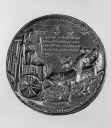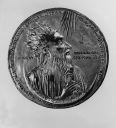Description
Obverse: Emperor Heraclius, bearded, wears a crown of tiara-type with pseudo-Byzantine acroteria. Represented as a bust portrait facing right. Lunar crescent below bust and rays of "Glory of God" in upper right.
Reverse: Heraclius in coach drawn by three horses moving to right, bringing back the cross plundered by the Persians to Jerusalem, above four lighted lamps.
Bibliography
Sales Catalogue, the Alphonse Kann Collection, Part I (New York, 1927), No. 352. Also, additional references. Xerox in dossier.
Cf. Hill, Dreyfuss Collection of Renaissance Medals, 1931, p. 238, pl. CXII, no. 525. Copy in dossier.
Cf. P. Verdier, The International Style: The Arts in Europe Around 1400, exh. cat. Walters Art Gallery (Baltimore, 1962), 144 and nos. 155, 156, 201, 202. Xerox in dossier.
R. Weiss, "The medieval medallions of Constantine and Heraclius," Numismatic Chronicle, seventh series, Vol. III (1963), 129 ff.
Cf. M. Jones, "The First Cast Medals and the Limbourgs, The Iconography and Attribution of the Constantine and Heraclius Medals," Art History 2.1 (1979): 35-44. Xerox in dossier.
Cf. Ex aere solido, Bronzen von der Antike bis zur Gegenwart, Berlin Staatlichen Museen (Berlin, 1983), p. 90, no. 53. Xerox in dossier.
Stephen K. Scher, The Currency of Fame: Portrait Medals of the Renaissance, exh. cat. The Frick Collection (New York, 1994), 32-37.
Tanja L. Jones, "The Constantine and Heraclius Medallions: Pendants between East and West," The Medal 56 (Spring, 2010), 4-12
Exhibition History
Lent to the Walters Art Gallery, March 31, 1963 - April 22, 1976.
Acquisition History
Arthur Läbbecke Collection in Brunswick (Braunschweig);
Alphonse Kann Collection, Saint Germain-en-Laye;
Paul J. Sachs (1878-1965), Cambridge, MA;
Gift of Paul J. Sachs, Cambridge, MA, January 15, 1949;
Dumbarton Oaks Research Library and Collection, Byzantine Collection, Washington, D.C.



